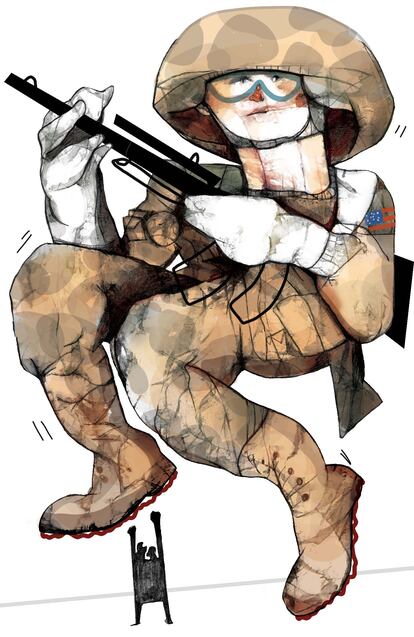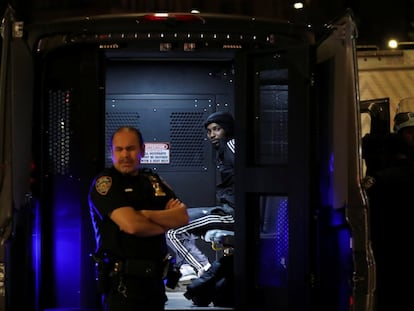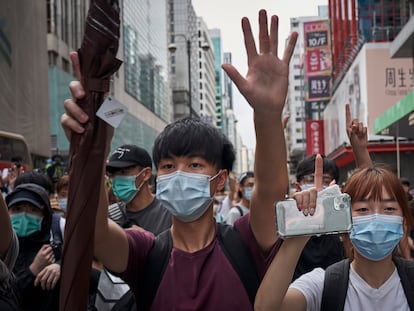The fall of the American counterrevolution
President Trump’s use of counterinsurgency practices to control the population has triggered the revolution he dreaded

In history, events usually unfold the other way around. Revolutions come first, and they spark counterrevolutions. But history – as with almost everything else in these times of pandemic – has been turned upside down.
In a startling reversal of the cycles of American history, President Donald Trump’s militarized response to the overwhelmingly peaceful protests has triggered a rebellious spirit that may well tip the 2020 elections. Trump was too transparent about his ambitions. In a meeting with governors, Trump explicitly called for a militarized response and “total domination” of the battlefield in order to eradicate protesters, whom he labeled domestic “terrorists,” imprison them for up to “10 years,” and impose, effectively, “an occupying force” in American cities.
Trump put the head of the joint chiefs of staff and the highest-ranking and most senior military officer, General Mark A. Milley, in charge of the federal government’s response. Trump repeatedly emphasized the need to “dominate” the battlefield. “The word is dominate,” he stressed. “If you don’t dominate your city and your state, they’re gonna walk away with you.” In DC, he assured, “we’re going to have total domination.”
President Donald Trump’s militarized response to the overwhelmingly peaceful protests has triggered a rebellious spirit that may well tip the 2020 elections
“I wish they had an occupying force in there,” Trump declared. His secretary of defense, Mark Esper, immediately jumped in, adding: “I agree, we need to dominate the battle space.”
The same day, Trump mobilized the military police and a US Army Black Hawk helicopter to control peaceful protesters, and deployed the 82nd Airborne Division to DC. And after tear-gassing and shooting peaceful protesters with rubber bullets to clear a path for that now-infamous presidential photo-op, Trump marched with his highest-ranking military general and his secretary of defense by his side – General Milley in full combat uniform.
Trump’s march was the culmination of a decades-long transformation of American politics. In The Counterrevolution: How Our Government Went to War Against Its Own Citizens (Hachette 2018), I documented the shift since 9/11 in how our political leaders govern in the United States. I showed how the hyper-militarized policing across the country was not merely the accidental result of Department of Defense procurement programs that have distributed billions of dollars’ worth of US military-grade equipment from Iraq and Afghanistan to small town police forces; but rather, that the militarized approach reflects a decades-long process whereby Americans have domesticated the practices and logics of counterinsurgency warfare from the wars in Iraq and Afghanistan.
Hyper-militarized policing, in effect, forms part of a new way that we, in the United States, govern ourselves at home and abroad, inspired by the rules of counterinsurgency warfare. It represents a momentous political transformation: not from the rule of law to a state of exception, as Giorgio Agamben and others suggested after 9/11, but rather from an earlier model of governing based on large-scale warfare to one modeled on tactical counterinsurgency strategies. And it traces, in important respects, back to the formative counterinsurgency practitioners, including French commanders in Indochina and Algeria such as Roger Trinquier, David Galula, and Paul Aussaresses, who refined that new style of unconventional warfare called “la guerre moderne.”
From Iraq and Afghanistan, these practices came home to roost in the United States. As Intercept reporter Jeremy Scahill writes: “all of the counterinsurgency tactics of these foreign wars have crept back home.” And in the last three years, Donald Trump has given the new counterinsurgency mode of governing a distinctively New Right, White Supremacist twist.
What was most surprising about it, though, was that it was a counterrevolution without a revolution. By contrast to Algeria or Vietnam where there were armed anti-colonial revolutions, here a counterinsurgency paradigm of governing emerged without any real insurgents. And this is where the history gets interesting.
The modern concept of revolution, born in the 18th and 19th centuries, marked a sharp break from earlier understandings in Antiquity of the cyclical transformation of politics – on the Platonic view, from aristocracy to oligarchy, democracy, and ultimately tyranny. The idea of revolution as the astronomical return to a point of origin was replaced by the notion of a watershed social transformation, a binary break bringing about, in Reinhardt Koselleck’s words, “the social emancipation of all men.”
Across the political spectrum, even among some Republican leaders, there is a growing sentiment that Trump passed a threshold
What we are witnessing today, by contrast, is a strange cycling back to the ancient kyklos, but now in reverse. Trump perfected the counterrevolution without an antecedent revolution. In the process, he finally triggered the revolution he dreaded. Perhaps he was too transparent about his military ambitions. After all, the main tactic of la guerre moderne was to psychologically win the hearts and minds of the passive masses. Explicitly sending in the troops may have been a step too far.
The result is that we have reached today a tipping point. Across the political spectrum, even among some Republican leaders, there is a growing sentiment that Trump passed a threshold. “Militarizing our response, as we witnessed in Washington, D.C., sets up a conflict – a false conflict – between the military and civilian society," Trump’s former Secretary of Defense and four-star US Marine Corps General Jim Mattis wrote in The Atlantic, rebuking the president.
Senior defense officials are now trying to distance the Pentagon from Trump’s infamous gassing and photo-op. Secretary of Defense Mark Esper, former president George W. Bush, and military leaders have roundly condemned the militarized response. Even a Republican senator, Lisa Murkowski from Alaska, objected to the militarization and says she is now struggling whether to support Trump in 2020.
In the media, there was an overwhelming backlash against The New York Times editors for publishing Republican Senator Tom Cotton’s op-ed Send In the Troops. And the most recent battery of polling data suggest that the American people disapprove of Trump’s handling of the protests.
“Perhaps we’re getting to the point where we can be more honest with the concerns that we might hold internally, and have the courage of our own convictions to speak up,” Republican Senator Murkowski said.
Yes, perhaps Trump has triggered that wave of revolutionary sentiment he feared. And perhaps, just perhaps, it will bring about the long-overdue eclipse of the American counterrevolution.
Bernard E. Harcourt is a professor at Columbia University Law School in New York and serves as Directeur d’études at the École des Hautes Études en sciences sociales in Paris. He is the author of several books, including ‘Critique and Praxis’ (Columbia University Press), which will be published in August.
Tu suscripción se está usando en otro dispositivo
¿Quieres añadir otro usuario a tu suscripción?
Si continúas leyendo en este dispositivo, no se podrá leer en el otro.
FlechaTu suscripción se está usando en otro dispositivo y solo puedes acceder a EL PAÍS desde un dispositivo a la vez.
Si quieres compartir tu cuenta, cambia tu suscripción a la modalidad Premium, así podrás añadir otro usuario. Cada uno accederá con su propia cuenta de email, lo que os permitirá personalizar vuestra experiencia en EL PAÍS.
¿Tienes una suscripción de empresa? Accede aquí para contratar más cuentas.
En el caso de no saber quién está usando tu cuenta, te recomendamos cambiar tu contraseña aquí.
Si decides continuar compartiendo tu cuenta, este mensaje se mostrará en tu dispositivo y en el de la otra persona que está usando tu cuenta de forma indefinida, afectando a tu experiencia de lectura. Puedes consultar aquí los términos y condiciones de la suscripción digital.
More information
Archived In
Últimas noticias
There is as much life left to discover on planet Earth as that which is already known
Dozens presumed dead, around 100 injured in fire at Swiss Alps bar during New Year’s celebration
Is porn for women different from conventional porn? We spoke to those who make it
Cartagena de Indias is sinking: What can the city do to mitigate it?
Most viewed
- Reinhard Genzel, Nobel laureate in physics: ‘One-minute videos will never give you the truth’
- David King, chemist: ‘There are scientists studying how to cool the planet; nobody should stop these experiments from happening’
- Sinaloa Cartel war is taking its toll on Los Chapitos
- Oona Chaplin: ‘I told James Cameron that I was living in a treehouse and starting a permaculture project with a friend’
- The Interoceanic Train, the Mexican alternative to the Panama Canal











































